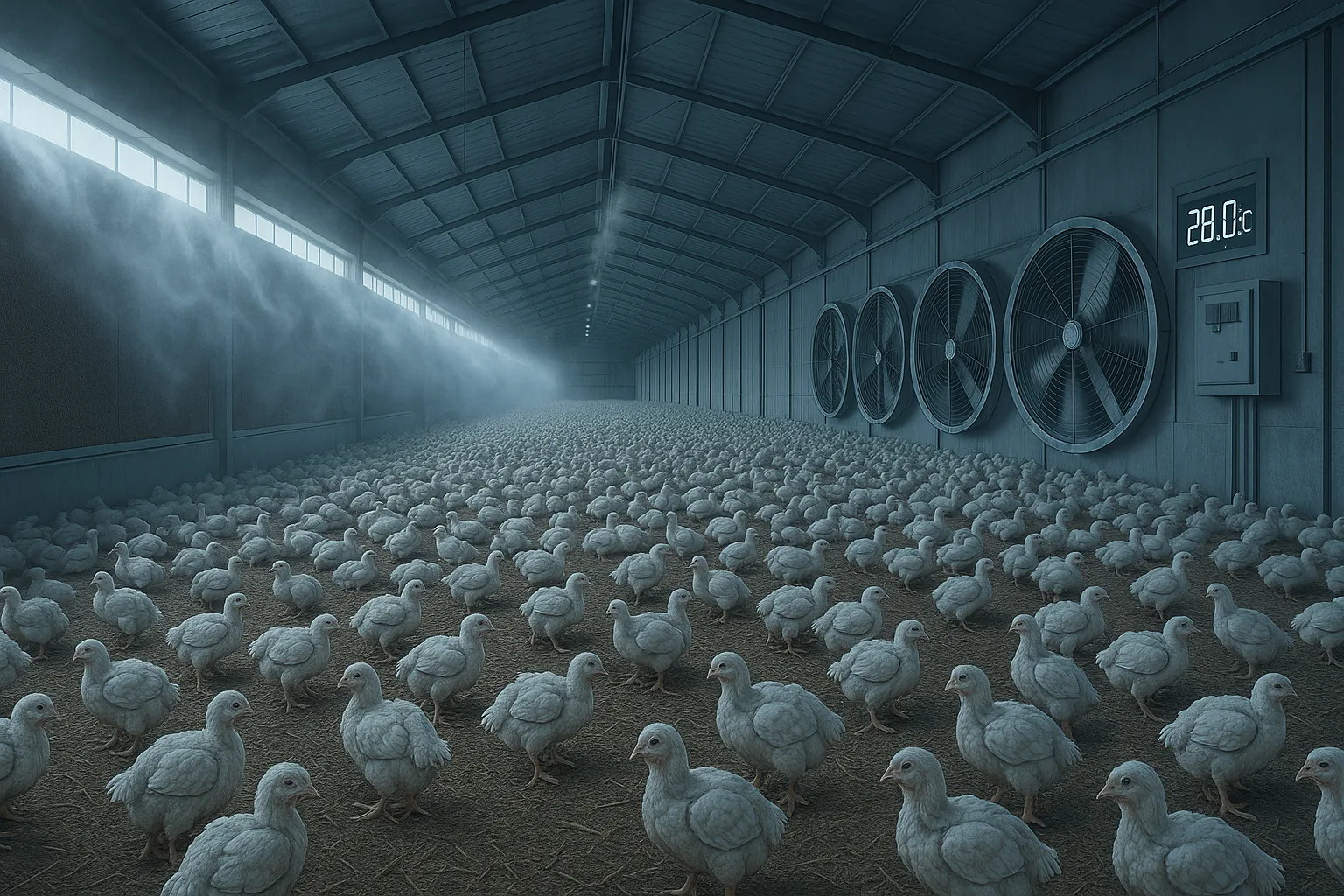Beat the Heat, Protect Your Profit: Essential Hot Weather Management for Broiler Farmers

Broiler chickens face a unique and critical challenge in hot weather. Their rapid growth rate, high metabolic heat production, and dense stocking make them exceptionally vulnerable to heat stress. Unlike backyard layers, even moderate heat waves can trigger devastating consequences: reduced feed intake, plummeting weight gain, increased FCR (Feed Conversion Ratio), dehydration, organ failure, and sudden mass mortality. Protecting your flock isn’t just animal welfare; it’s fundamental to protecting your bottom line. Here’s your targeted guide to managing broilers through scorching temperatures.
1. Environmental Control is Paramount: Engineering Coolth
- Tunnel Ventilation (Non-Negotiable for Large Houses): This is the gold standard. Maximize air speed (2.5-3.0 m/s at bird level) to create wind chill. Ensure proper inlet configuration and fan capacity. Clean fans, shutters, and evaporative cooling pads daily during heat waves. Even slight reductions in airflow drastically increase risk.
- Evaporative Cooling Systems:
- Cooling Pads: Most effective in low-humidity climates. Ensure pads are uniformly wet and clean (scale buildup drastically reduces efficiency). Monitor water temperature to the pads – use chilled water if possible.
- Fogging/High-Pressure Misting: Effective in higher humidity than pads. Use ultra-fine mist that evaporates before hitting the birds. Soaking birds or litter is disastrous. Install nozzles carefully to ensure even distribution and prevent wet spots. Run cycles before peak heat, timed with ventilation cycles.
- Insulation & Reflectivity: Ensure house roofs and walls are well-insulated. Consider applying reflective white paint to roofs to significantly reduce radiant heat load inside. Seal air leaks.
- Reduce Stocking Density: If facing extreme, prolonged heat, consult with your integrator/vet about temporarily reducing bird density. More space per bird improves air circulation and reduces heat load.
- Dark-Out Houses & Light Management: Utilize blackout capabilities to shift feeding times to cooler night hours. Reduce light intensity during peak heat to lower activity and heat production.
2. Water: The Lifeline Under Heat Stress
- Maximize Flow & Accessibility: Ensure water pressure and flow rates meet the flock’s peak demand (significantly higher in heat). Check all nipple drinkers – clogged nipples are deadly. Add extra lines or temporary bell drinkers if flow capacity is borderline. Flush lines regularly with cool water.
- Keep Water Lines Cool: Insulate main water lines outside the house. Run lines underground where possible. Paint exposed lines white. Consider chilling water at the source if feasible, especially for nipple systems.
- Electrolytes & Acidifiers: Add poultry-specific electrolytes to the water proactively during forecasted heat waves. They encourage drinking and replace vital minerals lost through panting. Consider water acidifiers (like citric or acetic acid) to improve palatability and potentially inhibit bacterial growth. Crucial: Provide plain water for part of the day (e.g., electrolyte in AM, plain water in PM) or ensure some lines remain plain water.
- Water Temperature is Critical: Aim for water below 25°C (77°F). Water above 30°C (86°F) will be consumed less, worsening dehydration. Monitor temperature at the drinker, not just the source.
- Pre-Hydration: Begin electrolyte supplementation and ensure optimal water flow before the heat peak hits, especially early morning.
3. Feed Management: Minimizing Metabolic Heat
- Feed Withdrawal Before Peak Heat: Cease feeding 4-6 hours before the predicted daily peak temperature. Digesting feed generates significant internal heat. Resume feeding in the cooler evening hours.
- Shift Feeding to Night: Deliver the majority of the daily feed ration during the coolest 8-10 hours of darkness. Use automated systems to facilitate this.
- Increase Feeding Frequency: If running feeders during heat, run them more frequently for shorter periods to prevent feed from heating up in the trough and to encourage consumption during brief cooler moments.
- Consider Nutrient Density (Consult Nutritionist): During prolonged heat, diets may be adjusted to maintain nutrient intake despite reduced consumption. This often involves increasing energy and amino acid density. Fat is a cooler energy source than carbohydrates. Never change feed without professional guidance.
- Avoid Overfeeding Prior to Heat Event: Birds carrying excess fat are far more susceptible to heat stress. Adhere strictly to growth curves.
4. Monitoring & Early Intervention: Data is Your Defense
- Temperature & Humidity Sensors: Place multiple sensors at bird level (not just at human height or ends of the house). Monitor Wet Bulb Temperature (WBT) – this is the critical metric for heat stress risk, combining heat and humidity.
- Bird Behavior Observation: Train staff to recognize early signs:
- Increased panting (beaks open, necks extended)
- Wings held away from the body
- Reduced activity, lethargy, birds spread out (avoiding contact)
- Reduced feed and water intake (monitor consumption curves closely!)
- Increased water spillage (sign of desperate attempts to cool)
- Weigh Birds: Track weight gain closely. Sudden drops signal heat stress impact.
- Daily Mortality Checks: Be vigilant for spikes, especially in the afternoons/evenings following heat peaks. Note location within the house (hot spots).
5. Emergency Response: When the Mercury Soars
- Have a Written Plan: Every farm must have a detailed, site-specific heat stress emergency protocol. Train all staff.
- Immediate Actions:
- Maximize Airflow: Ensure all ventilation systems (tunnel fans, stir fans) are running at 100%. Open all possible inlets.
- Activate Cooling: Run fogging/misting only if humidity allows for evaporation. Run cooling pads continuously. Ensure pumps and pads are functioning.
- Reduce Activity: Dim lights to minimum intensity. Halt any non-essential activity in the house (catching, vaccinations).
- Water Boost: Flush water lines with cool water. Ensure electrolyte solution is fresh and available. Consider adding temporary supplemental drinkers.
- Target Hot Spots: Use portable spot fans or misters in areas where birds are congregating or showing severe distress.
- Post-Heat Recovery: Continue enhanced cooling and electrolyte support into the night. Monitor birds closely for delayed mortality or secondary issues like necrotic enteritis. Assess feed intake and weight gain recovery. Evaluate system performance – what failed? What needs improvement?
Broiler-Specific Critical Considerations:
- Age Matters: Older birds (4 weeks +) are MUCH more susceptible than younger chicks due to body mass and feather cover. Be hyper-vigilant as flocks approach market weight.
- Body Weight & Uniformity: Heavier birds and less uniform flocks suffer disproportionately. Culling severely distressed birds may be necessary to save the majority.
- Litter Management: Wet litter from malfunctioning cooling systems or excessive spillage creates ammonia and humidity, worsening heat stress and health. Manage moisture aggressively.
- Power Failure Backup: Generators are essential. Test regularly. Have a plan for immediate ventilation restoration during outages.
- Integrator Communication: Work closely with your service tech and integrator. Report issues early and follow their specific protocols.
Proactive Management = Profit Protection
For broiler farmers, hot weather management isn’t a collection of “hacks” – it’s a core operational imperative requiring investment, planning, and constant vigilance. The costs of heat stress – mortality, reduced growth, higher FCR, downgrades, vet bills – far outweigh the costs of proper ventilation, cooling systems, and proactive protocols. By prioritizing environmental control, water management, strategic feeding, and rigorous monitoring, you safeguard your birds’ welfare and your operation’s economic viability through the toughest summer heat. Stay cool, stay alert, and protect your flock.
